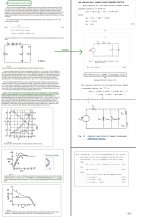Wouldn't a variovent be modeled as a resistance?Hi,
There are good circumstances to use series caps and poor ones.
They are no worse than series caps used on midranges and tweeters.
rgds, sreten.
(Without even mentioning damping factor.)
Ben
Wouldn't a variovent be modeled as a resistance?
(Without even mentioning damping factor.)
Ben
Hi Ben,
You're absolutely correct!
b 🙂
Attachments
Last edited:
There are good circumstances to use series caps and poor ones.
They are no worse than series caps used on midranges and tweeters.
They are bad enuff on mids & tweeters and on a woofer they need to deal with the resonant peak and are very large, very expensive (or electrolytic)
dave
They are bad enuff on mids & tweeters and on a woofer they need to deal with the resonant peak and are very large, very expensive (or electrolytic)
Even MKP (I have many Aerovox MKPs), when the size is big, I think the effect is worse than normal small MKP. I have also tried some very expensive electrolytics but after listening (and waiting for break-in) I decided to avoid this series cap approach.
Just because you cant sim a variovent, doesnt mean it doesnt work.
you can basically make up Thiele/Small as you please.
you can basically make up Thiele/Small as you please.
Oh, sorry.
I suspected you had developed a cap-fetish.
Apparently its me, that is not quite alert.
I suspected you had developed a cap-fetish.
Apparently its me, that is not quite alert.
I decided to avoid this series cap approach.
That was with a 2-way speaker (fx=2k6Hz). I think I will try again with 3-way active (fx=320Hz), but doubt it will be easy as the phase is affected. I really like to avoid big enclosure for the high Qts woofer.
You can avoid big enclosures, if you stuff your variovent appropiately.
No need to consider calculations except for tracking impedance.
Phase i less important because it dances, as it pleases.
It can be 720 degrees out and you wont notice until you are told.
No need to consider calculations except for tracking impedance.
Phase i less important because it dances, as it pleases.
It can be 720 degrees out and you wont notice until you are told.
sorry Mooly
Jay
I think a two-way is going to stretch the concept too far.
Then you will still need help, either in the middle or top.
Back to not understanding the idea.
Its a trial and error thing.
Jay
I think a two-way is going to stretch the concept too far.
Then you will still need help, either in the middle or top.
Back to not understanding the idea.
Its a trial and error thing.
I think a two-way is going to stretch the concept too far.
Then you will still need help, either in the middle or top.
Back to not understanding the idea.
Its a trial and error thing.
Snup
I don't understand the first 3 statements.
Regarding box type, I usually choose based on driver parameters and also my own requirement on size and the lowest frequency to cover. But for modeling only, of course I try all to see which one is the most suitable (And more often than not I build all types and compare)
When there's no issue with bass extension, I will usually prioritize sealed enclosure because I like the sound. Some times I need this (LR2 alignment) so I can easily add additional woofer to cover the lower bass.
Sometimes I have a need to make a smallish enclosure. That's why I tried the series capacitor loading. Stuffing the box is also helpful to achieve similar objective (but only marginally). I have also used Linkwitz Transform and similar circuits. And this "variovent" is a good idea. I have tried MANY ideas that can be considered a variovent, including the denim approach.
These days I prefer electronic approaches tho.
- Status
- Not open for further replies.
- Home
- Loudspeakers
- Subwoofers
- Modeling a variovent

